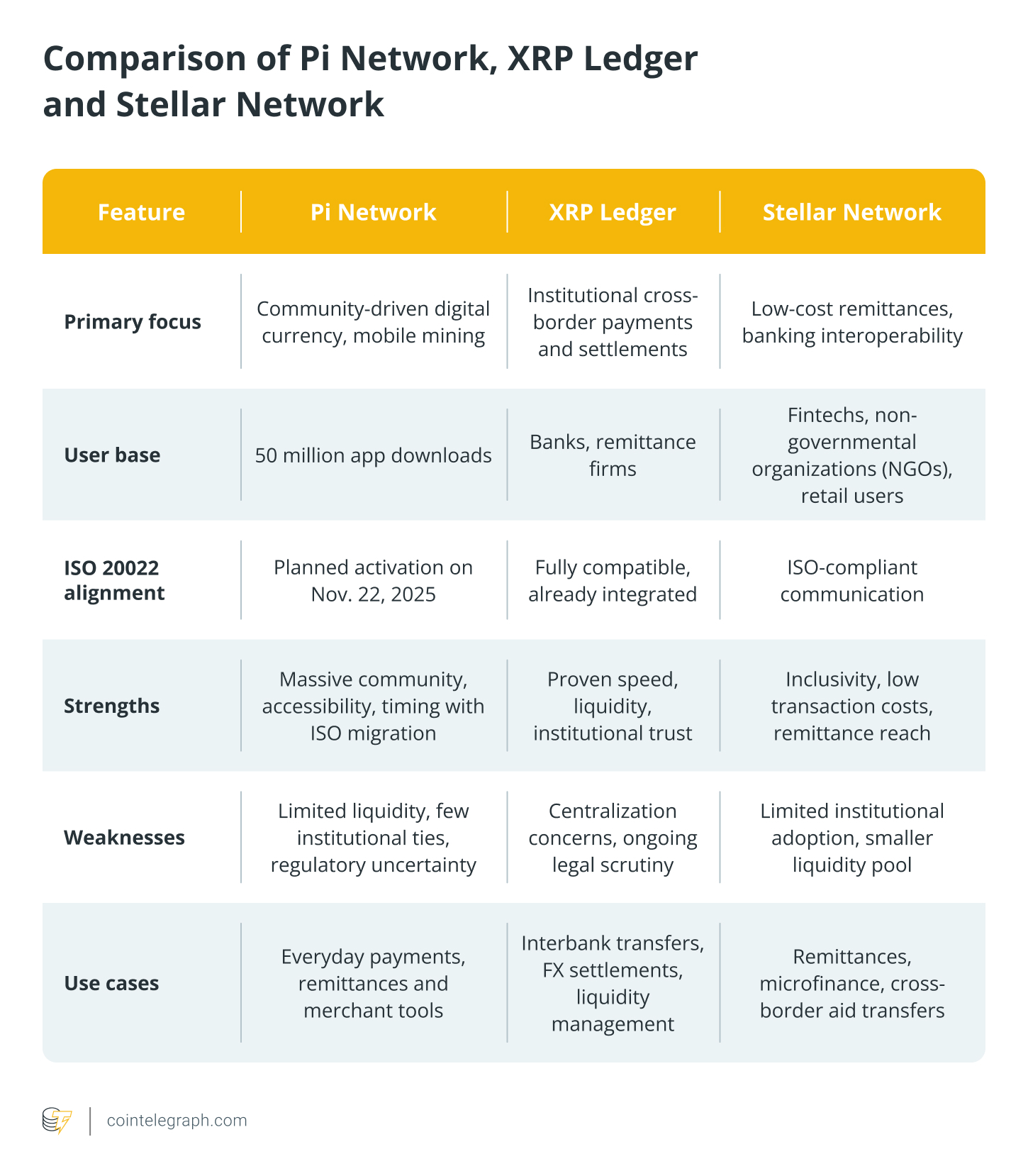
Assessing Pi Network’s ISO 20022 Upgrade Against XRP Ledger and Stellar Network
An exploration of Pi Network's strategy to adopt the ISO 20022 standard and its implications for global digital payments.
Assessing Pi Network’s ISO 20022 Upgrade Against XRP Ledger and Stellar Network
What is ISO 20022, and Why is It Important?
ISO 20022 sets a global standard for how financial institutions share information about transactions such as payments and securities. This replaces older, disjointed messaging systems with a cohesive format that facilitates communication among banks, fintech firms, and payment networks worldwide.
Embracing ISO 20022 boosts cross-border compatibility by allowing detailed transaction data (e.g., purpose, sender, receiver details) to be shared securely and effectively. This enhances transparency, minimizes errors, and hastens international transfers.
The worldwide transition to ISO 20022 is a significant step toward modernizing finance. Key organizations like SWIFT and the US Federal Reserve are adopting this standard, aiming for complete implementation by November 22, 2025. After this date, most financial institutions linked to SWIFT’s network are expected to use ISO 20022 for seamless global payments.
What is Pi Network’s ISO 20022 Strategy?
Pi Network plans to implement the ISO 20022 standard in three stages:
- Preparation before November 2025
- Activation on November 22, 2025
- Adoption post-launch
With over 50 million app downloads, Pi aims to introduce tools for cross-border transactions, digital wallets, and a decentralized exchange (DEX) to facilitate real-world applications.
By adopting ISO 20022, Pi Network looks to integrate smoothly with banking systems, enabling swift, cost-efficient, and transparent digital transactions. This transition could transform Pi from a community-focused initiative into a recognized player in the global payments arena, bridging cryptocurrency with traditional finance.
Did you know? Unlike Bitcoin, Pi Network allows users to “mine” coins by merely tapping a button, positioning it as one of the largest social crypto experiments.
Comparing Pi Network with XRP Ledger and Stellar Network
Ripple’s XRP Ledger and Stellar Network are established blockchain solutions for international payments and financial integration. While XRP Ledger provides rapid remittance options with near-instant settlement, Stellar is geared towards financial inclusion, offering low-cost transfers and improved access to banking for underserved groups.
Both networks comply with ISO 20022 standards. The XRP Ledger supports necessary messaging formats via Ripple’s enterprise offerings, and the Stellar Network’s design is compatible with standardized communication for finance, thus making it interoperable with ISO systems.
Pi Network’s strategic connection with the ISO 20022 transition focuses on emerging markets. While it offers broad community engagement and accessibility, it currently lacks the partnership clout, liquidity, and established history that characterize XRP Ledger and Stellar Network.
The primary test for Pi Network is whether it can transcend mere imitation to cultivate the trust, engagement, and solid ecosystem required to compete with XRP Ledger and Stellar.
 Comparison of Networks
Comparison of Networks
Opportunities and Challenges for Pi Network
As Pi Network approaches its ISO 20022 upgrade, it faces key opportunities and potential pitfalls. Its strategy, focused on mobile usage and a user base exceeding 50 million, can promote financial inclusion in regions like Africa, Asia, and Latin America, where banking access remains scarce.
The upcoming global transition to ISO 20022 by November 2025 offers Pi Network a strategic chance for integration into international payment systems and expansion into digital remittances.
However, critical challenges lie ahead. Establishing institutional trust, adhering to regulatory standards, and ensuring sufficient liquidity are essential for its token economy. The successful launch of its mainnet, DEX performance, and merchant uptake will be vital for long-term credibility.
Potential uses may include remittances, merchant transactions, and future collaborations with governments or fintech companies. Although the alignment with ISO 20022 brings new possibilities, the global success of Pi Network hinges on achieving sustainable real-world adoption post-upgrade.
Did you know? XRP transactions through the XRP Ledger settle within three to five seconds, which substantially enhances the efficiency of global payments compared to traditional banking systems.
Future Benchmarks and Scenarios for Pi Network
For Pi Network to gain global recognition, it must convert its technical goals into tangible adoption. Crucially, it must meet the credibility benchmarks comparable to those of Ripple’s XRP Ledger and Stellar Network. This includes:
- Developing partnerships with banks and financial institutions
- Achieving significant volumes of cross-border transactions
- Gaining visibility and adoption from merchants and government bodies
Robust liquidity, active participation in its DEX, and a flourishing app ecosystem will signal substantial adoption. Essential metrics to monitor include announcements regarding bank or fintech partnerships, progress on mainnet activation, and trading in emerging-market remittance corridors.
Three potential scenarios may emerge for Pi Network’s future:
- Best case: The Pi Network becomes the third key player aligned with ISO 20022, alongside XRP Ledger and Stellar.
- Moderate case: The Pi Network carves out a vital niche in remittances within developing economies without reaching the scale of XRP Ledger or Stellar.
- Worst case: Technical, regulatory, or adoption challenges hinder Pi Network from attaining meaningful cross-border scale.
Did you know? Stellar, founded by Jed McCaleb (co-founder of Ripple), aims to promote financial inclusion and has facilitated humanitarian aid via crypto, showcasing its real-world potential.
Pi Network’s ISO 20022 Upgrade: Reality or Overhyped Aspirations?
The upcoming ISO 20022 upgrade for Pi Network lays a fundamental framework for global integration, yet tangible success demands more than just technical compliance. To hold its ground against XRP Ledger and Stellar Network, Pi Network must demonstrate its practicality, reliability, and ability to forge institutional partnerships that endorse its significance in actual finance.
With the November 22, 2025 activation approaching, Pi Network aims to foster inclusive digital payments that could increase systematic financial engagement in emerging markets. Transforming this ambition into reality will necessitate clear governance, adherence to regulations, and a seamless user experience across wallets, DEXs, and merchant solutions.
Post-launch indicators such as transaction volumes, liquidity growth, and recognition from financial institutions will be crucial in appraising whether Pi Network heralds a new era in digital finance or merely represents an overhyped cryptocurrency vision.



